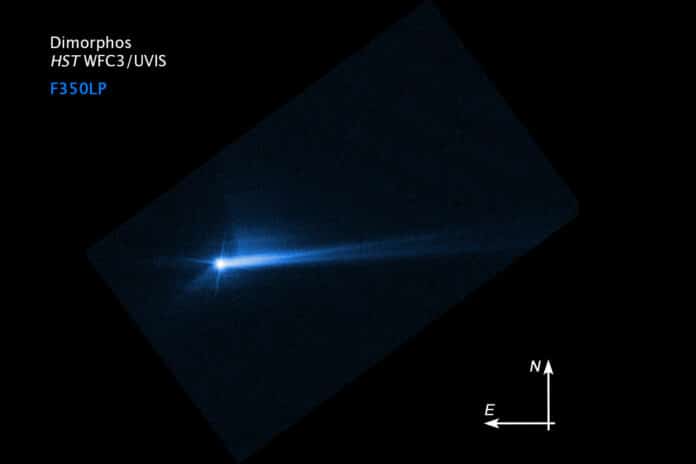NASA’s Double Asteroid Redirection Test (DART)is the first-ever mission dedicated to investigating and demonstrating one method of asteroid deflection by changing an asteroid’s motion in space through kinetic impact. By analyzing the data obtained over the past two weeks, the investigation team shows the spacecraft’s kinetic effect successfully altered the asteroid’s orbit.
It is the first time that a celestial object has been purposefully altered by humanity, and it also represents the first large-scale application of asteroid deflection technology.
On Sept. 26, the spacecraft successfully impacted its asteroid target- Dimorphous. Since the impact, astronomers have been using telescopes on Earth to measure how much that time has changed.
Now, the investigation team has confirmed the spacecraft’s impact altered Dimorphos’ orbit around Didymos by 32 minutes, shortening the 11-hour and 55-minute orbit to 11 hours and 23 minutes. This measurement has a margin of uncertainty of approximately plus or minus 2 minutes.
Lori Glaze, director of NASA’s Planetary Science Division at NASA Headquarters in Washington, said, “This result is one important step toward understanding the full effect of DART’s impact with its target asteroid. As new data come in each day, astronomers can better assess whether and how a mission like DART could be used in the future to help protect Earth from a collision with an asteroid if we ever discover one headed our way.”
The investigative team is still gathering data using ground-based observatories throughout the globe and radar equipment at the National Science Foundation’s Green Bank Observatory in West Virginia and the NASA Jet Propulsion Laboratory’s Goldstone planetary radar in California. They are updating the period measurement with repeated observations to increase its accuracy.
The emphasis is now shifting to quantifying the effectiveness of momentum transfer from DART’s impact with its target at a speed of around 14,000 miles (22,530 kilometers) per hour. This involves a deeper examination of the “ejecta”—the several tonnes of asteroidal rock that the impact dislodged and sent into orbit. The push that DART made on Dimorphos was greatly aided by the recoil from this explosion of debris, much like how a balloon is propelled in the opposite direction by a jet of air.
More information on the asteroid’s physical properties, such as the characteristics of its surface and how strong or weak it is needed to understand the effect of the recoil from the ejecta. These issues are still being investigated.
Nancy Chabot, the DART coordination lead from the Johns Hopkins Applied Physics Laboratory (APL) in Laurel, Maryland, said, “DART has given us some fascinating data about both asteroid properties and the effectiveness of a kinetic impactor as a planetary defense technology. The DART team continues working on this rich dataset to understand this first planetary defense test of asteroid deflection fully.”
